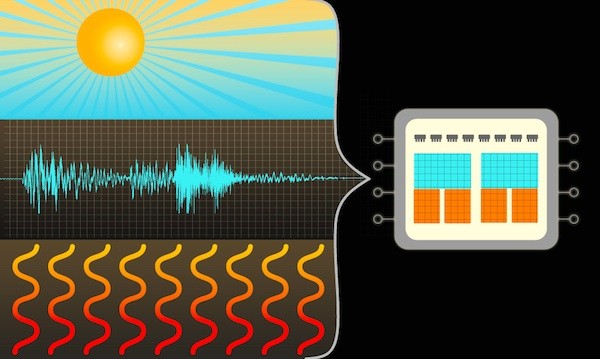MIT researchers have developed a chip which can harvest energy from three ambient sources at the same time: natural light, heat and vibrations.

This combination energy harvesting chip is a significant step toward battery-free monitoring systems, with applications in the biomedical devices, environmental sensing and remote operations sectors.
It is expected that the new multi-power chip will be used along with low-power chips that can collect data and relay it to a central facility. By efficiently using multiple power sources in a single device, the new power supply chip mitigates the problem of intermittency and unpredictability which plagues energy from ambient sources.
Individual devices which harness single ambient sources, such as the difference between body temperature and outside air, or the motions and vibrations of anything from a person walking to a bridge vibrating as traffic passes over it, have already been developed.
But combining the power from these variable sources requires a sophisticated control system. Each energy source usually requires its own control circuit to meet its own requirements, since different voltages can be harvested from different sources.
For example, circuits to harvest thermal differences typically produce only 0.02 to 0.15 volts, while low-power photovoltaic cells can generate 0.2 to 0.7 volts and vibration-harvesting systems can produce up to 5 volts.
The real challenge for the united circuit is coordinating these disparate sources of energy in real time to produce a constant output. The researchers have taken the real-time, simultaneous approach, as opposed to earlier attempts, which simply switched among the multiple energy sources.
The researchers also had to minimise the power consumed by the control circuit itself, to leave as much as possible for the actual devices being powered, optimising the amount of energy extracted from each source.
The system uses a dual-path architecture. This allows the end device to be efficiently powered from a storage device or directly from the source, as opposed to being reliant on just the storage device, which in turn has to be charged up from the power sources.
The chip uses a single time-shared inductor, a crucial component to support the multiple converters needed in this design, rather than separate ones for each source.